Those of you who have read a few of my posts will know that, in the Venn diagram of my life, the ‘biodiversity and natural history’ set occupies a large space, as does the ‘literature’ set; and the set of a certain small child is expanding rapidly too. At the intersection of these three sets, it is striking just how chock full of animals children’s books are. One wonders, then, just what all these talking elephants and big bad wolves are teaching kids about the biodiversity of our planet. In a nice paper has just come out in PLoS ONE, examining children’s attitudes towards biodiversity, the authors have assessed the abilities of 7-11 year old schoolkids to identify ‘local’ species – those that they might actually see near where they live – and ‘exotic’ species, which are typically charismatic and tend to be over-represented in the many forms of media to which children are exposed, from books to Disney films. Perhaps not surprisingly, the kids are much more familiar with the charismatic exotic species, and what is more, they would prefer to protect these virtual (unseen) animals over those which live locally.
Now of course there is no substitute for getting outside and learning natural history through observation, but books (and other media) can play a part too. And not all books focus on megafauna from far-off lands. Indeed, the author of some of the most iconic of books for young children has championed everyday creepy-crawlies: Eric Carle is best known for a certain peckish Lepidoteran larva, but has also written books featuring crickets, moths, and cicadas as well as ladybirds, fireflies and spiders. And my son is now enjoying a story about a hermit crab, anemone, and bristleworm sharing a shell, by our current children’s laureate, Julia Donaldson.
There are some other great books around with a focus on the wonders of the familiar. Simon James writes and illustrates some lovely stories about the joys of exploring at the seaside (Sally and the Limpet) or in the woods down the road (The Wild Woods). Harris Finds His Feet by Catherine Rayner is a strikingly illustrated story of a young hare and his granddad. And let’s not forget that the classic fairy tales are full of animals that used to be local (wolves, bears), too. So I do think that the less exotic species do get a look in, at least, among the pandas, tigers and hippopotami.
As a scientist reading these books, of course, I tend to pick up on little natural history inaccuracies, and can’t help dwelling on them. I am perfectly happy to accept talking animals and fanciful storylines, but get the number of legs wrong on a caterpillar and it will bug me forever!
My pedantry comes to the fore every time I open Chris Wormell’s One Smart Fish. I actually think it’s a really clever attempt to tell the story of evolution, through the longing of a particularly clever fish to walk on land (he tries it and gets bored; but triggers, over ‘hundreds of millions of years’, as the book nicely points out, the evolution of all four-legged land animals). No problem with that. But what annoys me is the bloody goldfish! Right there in the sea with all the other marine fish, this pretty member of the exclusively freshwater carp family!
As for whether my son grows up enjoying local nature, or pines for something more exotic, well, who knows. But just now he’s rather keen on a certain quangle wangle, and I don’t think we get crumpetty trees in Yorkshire…

